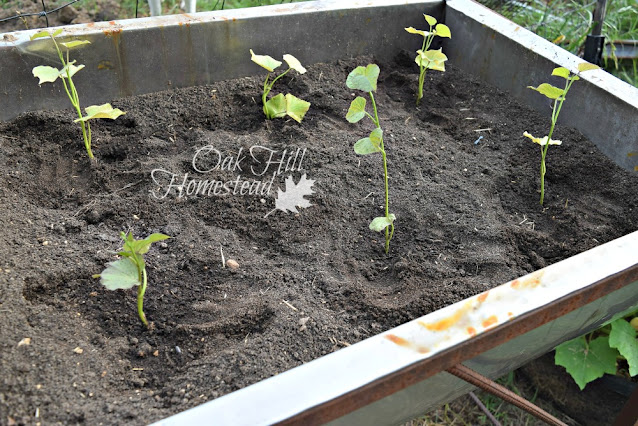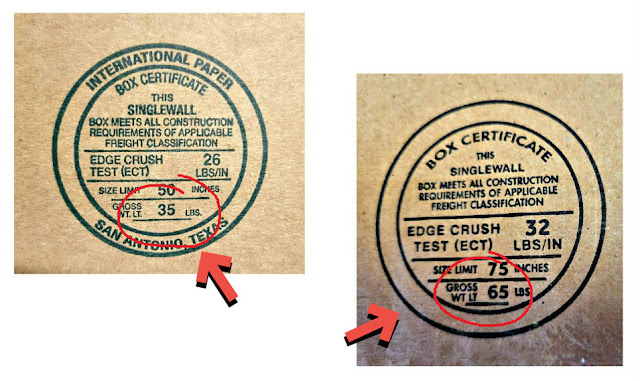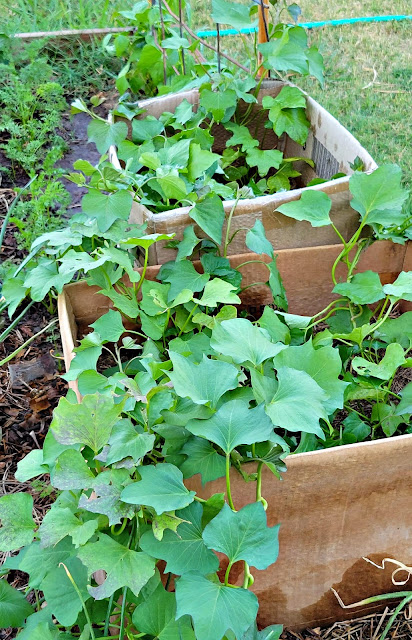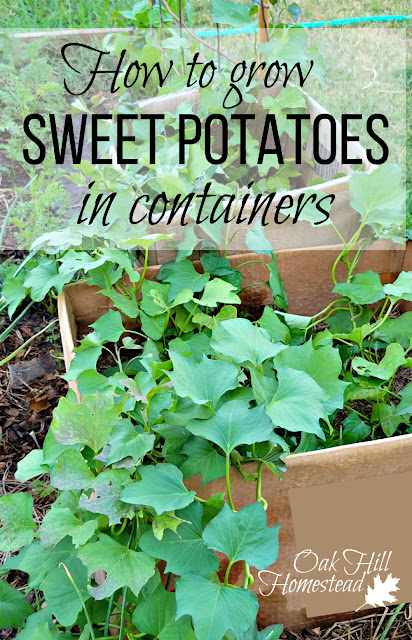Learn how to grow sweet potatoes in containers - a delicious and easy-to-grow crop for beginning gardeners.
These easy steps will show you how to plant and care for your plants so you can harvest your own crop of delicious sweet potatoes.
Now matter how much space you have, growing sweet potatoes in containers is a great option. Containers not only increase your growing space but also give you control over the soil and the growing conditions.
It's easy to grow your own sweet potatoes in containers!
How to Grow Sweet Potatoes in Containers or Raised Beds
I'm a big fan of container gardening. Containers help to expand your garden space. You can create a vegetable garden where you don't even have dirt by using containers.
I'm also a fan of using whatever you have as containers. I'll share some suggestions and some unusual containers I've used further down in this article.
Why grow sweet potatoes?
Sweet potatoes are a crop worth growing for their nutritional value. Very high in vitamin A, sweet potatoes are also a good source of fiber, rich in potassium, and low in calories.
The plants are also extremely pretty. Often grown as ornamental plants, the vines make a sprawling cascade from containers. The leaves and flowers are also edible.
Sweet potato plants love summer's heat. They are extremely frost-tender and cannot stand cool soil or cool temperatures.
 |
| You can grow sweet potatoes in containers (yes, even a cardboard box). |
You'll find more warm-weather plants to grow in your backyard garden in this post.
Sweet potatoes are not the same as yams
In spite of the names being almost interchangeable, yams and sweet potatoes aren't the same thing.
Yams are grown in Latin America, the Caribbean region, Asia, and West Africa, and can grow up to 45 feet long.
Sweet potatoes, on the other hand, are much smaller, have a softer skin and the texture is different. They grow in the New World (basically, the Americas), have a softer skin and are much higher in beta carotene.
Sweet potatos are not the same as potatoes
Also, sweet potatoes and "Irish" potatoes are not the same, and growing sweet potatoes is very different than the methods for growing potatoes.
Why grow sweet potatoes in containers?
Containers increase your garden space, providing new planting opportunities in small spaces.
Containers also help to keep your plants safe from garden marauders. The first time I tried to grow sweet potatoes I planted them in the ground, and an armadillo dug them up and ate them.
If you have gophers, moles or armadillos, growing sweet potatoes in containers might be the best way to thwart these varmints.
 |
| Sweet potatoes growing in Rubbermain bins. Drainage holes were drilled in the bottom. |
Sweet potatoes grow very well in containers and are very adaptable. They do have space and soil requirements that you need to take into consideration though.
The best container to grow sweet potatoes
Because the sweet potato tubers grow underground, large and deep containers are the best match for these plants. A container holding about 15-20 gallons is a good size.
Half whiskey barrels hold about 16 gallons and are readily available at nurseries. Plant 3-4 slips in each half barrel.
My favorite is to use tubs that held cattle minerals, since I live in a region known for raising beef cattle.
These are often free from cattle producers, although now that these containers have become more popular with gardeners, ranchers are often charging a couple of dollars apiece for them now. They're still a great bargain, and are great for growing sweet potatoes.
You'll need to drill drainage holes along the bottom for drainage. Sweet potato vines like well-draining soil.
Can you grow sweet potatoes in 5-gallon buckets?
You can grow sweet potatoes in 5-gallon buckets, but you probably won't get as large a harvest as you would from larger containers. Plant just one slip in each bucket.
Like all containers, buckets need to have drainage holes and well-draining soil.
.
Can you grow sweet potatoes in fabric grow bags?
Grow bags are not the best container choice for sweet potatoes. They aren't deep enough or big enough to allow the tubers to develop. You'd probably still get a small harvest though.
However, if you are growing sweet potatoes for their foliage instead of the tubers, you can grow them in fabric bags.
Can you grow sweet potatoes in raised beds?
If your raised bed is at least 12 inches deep and filled with well-draining, loose and fertile soil, you can grow sweet potatoes in it.
Some unusual containers to grow sweet potatoes
I've grown my sweet potatoes in some unusual containers, because I believe in using what you have.
My first sweet potatoes grew in a metal sink. It was a homemade double sink affair, with a welded frame that held two metal half-barrels. They each had a drain hole, which gave excellent drainage. I set it so that the end with the drain holes was lower than the other end to allow for the best drainage.
This year I'm growing my sweet potatoes in plastic storage totes with plenty of holes drilled in the bottom.
I've even grown sweet potatoes in cardboard boxes!
Not just ordinary cardboard boxes, though. I used heavy-duty boxes.
Look on the bottom of the box for a seal like the one in the photo. Choose boxes with the highest number for the best results.
I set these boxes on top of my raised bed, which wasn't deep enough on its own to successfully grow sweet potatoes.
The bottom flaps of the boxes were folded up against the sides, so that the boxes were bottomless. The top flaps were also folded inside, so the sides had a double-thickness of cardboard.
 |
| Growing sweet potatoes in cardboard boxes on top of my raised beds doubled the amount of soil depth available to my plants. |
This allowed the roots to grow down from the box into the raised bed soil below, more than doubling the amount of soil they had access to.
You'll find more tips on growing vegetables in cardboard boxes here.
How far apart to plant sweet potatoes
The recommended spacing between sweet potato slips is 12-18 inches apart when planting them in rows, with 3 feet between the rows.
When you garden in containers you can place plants closer together. Just give them as much space to make those tubers underground as you can. The more space you can give them, will probably give you a larger harvest, as well as bigger sweet potatoes.
Each sweet potato plant produces an average of 3-5 tubers. If you have optimum growing conditions - space, loose soil, hot weather, and so on - you may get even more.
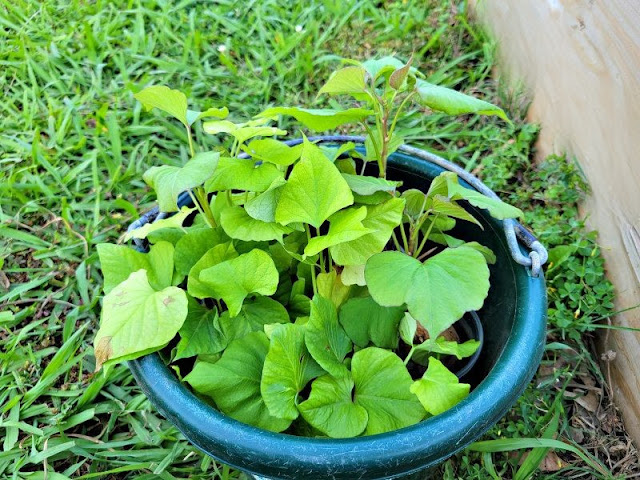 |
| A bucketful of sweet potato slips, ready to plant. |
NOTE: I probably over-planted all of my containers. I had more slips than I thought I did and only had so many containers. Remember that when you look at my photos!
The best soil for sweet potato plants
Sweet potatoes need well-drained soil that is rich in organic material and very fine, even sandy. That makes sense, since root vegetables develop underground and need loose soil that allows the tubers to grow.
You can improve less-than-perfect soil by adding lots of compost and organic materials and, if needed, sand to good quality potting soil to improve the soil's texture.
Well-draining soil is necessary, so the sweet potato tubers don't rot in wet conditions. Your containers should have plenty of drainage holes in the bottom, and also some holes in the sides about 1" up from the bottom if possible.
Planting sweet potato slips in containers
Sweet potatoes are grown from "slips," small rooted plantlets that grow from the eyes of a mature tuber, not from seeds. Slips are often started by placing a sweet potato in a jar of water.
 |
| Growing sweet potato slips in the kitchen windowsill. |
They can also be grown from mature sweet potatoes that are planted in the ground. In this case, the slips grow in the soil from the tuber.
Start your own slips in late winter so you can plant them in soil when the weather is warm enough. You can read how to start our own sweet potato slips in water here.
Because sweet potatoes are frost tender, they cannot survive cold weather. They shouldn't be planted until well after the last spring frost, when the soil temperature is at least 60° degrees Fahrenheit. Nighttime temperatures should be at least 60°F.
Slips are easy to plant. Dig a hole deep enough to accomodate the slip's roots, and fill the hole with water. Let the water soak in, then set the slip in the hole with at least two leaves above the soil level. Cover gently with soil.
Additional roots will continue to grow from the leaf nodes that are underground (where the stems of leaves attach to the stems), so don't be afraid to bury them deeply.
If you're planting sweet potato slips in very hot weather, plant them in the evening to avoid the hot sun.
 |
| Mulch sweet potato slips with straw to help retain moisture. |
Caring for sweet potato plants
When slips are first planted, they should be watered daily for the first week or so. During the second week they can be watered every other day. After that, once a week watering is sufficient. Mulch the soil to help retain moisture.
The plants should have an inch of water each week. They are happy growing in rather dry soil.
Cut back on watering during the final 3-4 weeks before harvesting to keep the tubers from splitting and to help them last longer in storage.
Sweet potato vines grow very quickly and can grow as long as ten feet before the end of the season. You can prune them back as needed when they are too long for your space. (And remember, those leaves and flowers are edible! You can cook them like spinach.)
A trick to grow bigger sweet potatoes
Sweet potatoes are vigorous growers. Everywhere that the stem of the plant touches the soil, roots will form.
This will result in more sweet potatoes, but they will be tinier. It's pretty easy to prevent this though, so that you'll have larger tubers.
All you have to do is put a barrier between the top of the soil and the joints of the sweet potato vines.
A simple way to do this is to tear brown paper bags into pieces and place them on top of the soil. The vines will touch the paper but won't grow new roots because they aren't actually touching the soil. The paper will get wet in the rain and allow water into the soil.
You can mulch on top of the paper pieces, or if you've already mulched, you can place the paper on top.
Pests and diseases that affect sweet potatoes
Like all crops, sweet potatoes can be affected by garden pests and diseases.
Streptomyces soil rot, southern blight, circular spot and root-knot nematode are the most common diseases in sweet potatoes. Learn more about these conditions and their causes and prevention at Gardenology.
Insect pests to watch out for include white grubs (the larval form of June beetles) in the soil, white-fringed beetles and flea beetles, as well as several types of weevils, rootworms and wireworms.
Learn more about the pests that can affect your sweet potatoes from the University of Florida Extension.
When to harvest sweet potatoes
Depending on the variety, sweet potatoes are ready to harvest after 90 to 120 days.
Sweet potatoes can be harvested when the leaves and the ends of the vines begin to turn yellow, or you can leave them in the ground until right before the first frost.
Frost will kill the vines, so don't procrastinate too long.
 |
| This sweet potato was damaged during harvest. It's better to put on your gardening gloves and dig down in the dirt to find the tubers than to use a shovel or gardening fork. |
In order to avoid cutting into the tubers when you harvest, put on your gardening gloves and dig them out by hand. It's too easy to scar them if you use a shovel or garden fork.
Curing sweet potatoes
Sweet potatoes need to be cured before you eat or store them. But don't worry, it's easy.
Pur your potatoes in a single layer in a warm, humid place - the temperature should be about 85°F and about 90% humidity.
After 4-6 days your potatoes should be cured. During this time the sugar content increases, the color of the flesh increases, and any small nicks or bruises should heal.
How to store sweet potatoes
You might be tempted to store sweet potatoes in the refrigerator, but this is not the ideal place.
Sweet potatoes should be stored in a cool, dry, dark and well-ventilated place, such as in a basement or root cellar. Don't store them next to a heat source such as a furnace or hot water heater. Your sweet potatoes should keep for about three months in this situation.
However, you can successfully store them for awhile in a dark corner of your pantry or even on your kitchen counter if you have a dark corner.
At room temperature sweet potatoes will last about one month. If one of your sweet potatoes is soft, discolored, or begins to ooze or smell, it has gone bad. You should add it to your compost pile instead of eating it.
Grow your own sweet potatoes in containers
Growing sweet potatoes in containers is a wonderful way to experience the joys of gardening and enjoy a bountiful harvest, regardless of your available space. With the right-sized containers, proper soil and a little time, you can harvest the rewards of homegrown sweet potatoes.
My mission is to inspire and encourage you to live a simple, joyful life,
no matter your circumstances or where you live. Join me here:
Facebook | Pinterest | Instagram | Subscribe



